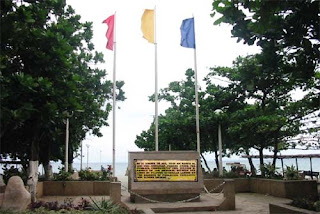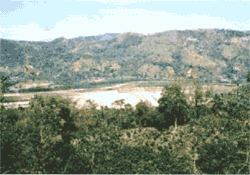Historical Background
The City of Talisay used to be an Agustinian estate in 1648 but only became a municipality in 1849 with Silverio Fernandez as its first gobernadorcillo and Pedro Labuca as capitan. Some accounts trace the origin of its name from Magtalisay trees abounding in areas while others claim origin of the name from a town in Spain. In both the American and Japanese occupations, Talisay served as haven of colonial forces. During World War II, the city served as the center of guerilla intelligence operations for the Philippine residence movement in Cebu. The returning American forces made their historic landing in the beach of Talisay on March 26, 1945 - an event that marked the eventual surrender of the Japanese forces in Cebu. The event is now annually commemorated by the provincial government of Cebu.
On December 30 2000, Talisay became a component city by virtue of Republic Act 8979.
Demography
The City of Talisay registered a total population of 150,128 in 2000 recorded in NSO Census of Publication book with an average population growth of 4.25 percent.
However, a special census conducted by National Statistics Office sometime in May 2000, specifically for the application of the then Municipality of Talisay for Cityhood yielded a population of 150,238 based on the number of residents working & studying in schools in other component cities, and residential subdivisions of the city. For the purpose of planning and drafting the CLUP 2001-2010, however, and considering the availability of socio-economic data, the NSO Population 2000 was used as basis.
There were a total of 28,751 households in 2000 and the population density was recorded at 36.23 persons/hectare. It is projected that the city's total population will reach 224,587 by 2010.
Based on the 1995 census figures, the dependency ratio of the City of Talisay was at 66 per cent. Cebuano is the predominant dialect (96 per cent) of the inhabitants of the city.
Geographical Characteristics
Talisay is a component city of the Province of Cebu in Central Visayas and forms part of the Metropolitan Cebu area. Located in the modern central quadrant of the province, it is bounded on the north by Cebu City, on the south by the Municipality of Minglanilla, on the west by Toledo City and on the east by Bohol Strait. It serves as an intermediary to the south of Metro Cebu and gateway to southern and western towns of the province.
The City of Talisay has a total land area of 4,370 hectares and has 22 barangays which are all considered urban. Its climate is characterized by a definIte dry season from November to May and a rainy season from June to October. Physically, the city consists of diverse landmass of varying terrain.
Agriculture & Natural ResourceS
Major crops grown in the agricultural areas of the city include corn, rice, vegetables, root crops and fruit crops. Poultry and livestock are raised to backyards and in large farms. In 1995, 10 large poultry farms were recorded in the city.
Seven (7) coastal barangays of the city are engaged to fishing activities. There are about 27 commercial fishing operators in Talisay with an aggregate annual production of 80 M. Inland fishing (fishponds) are also established in some barangays. A number of the coastal barangays are also engaged in fish processing.
HISTORICAL LANDMARKS
STA. TERESA DE AVILA PARISH
Built in 1836 and considered as one the oldest parish church in the country, where Talisaynons advocate Sta. Teresa de Avila as Patroness. Situated at Poblacion in front of the old city hall. It could be visited anytime.
AMERICAN LANDING SITE
During the world war ll, Talisay became the center of guerilla intelligence operation because of its strategic location and favorable natural condition. The returning American Forces who were then in contact with the Filipino counterparts, made their historic landing along the beaches of Talisay and is located at the back of the old city hall building.
TALISAY LIBERATION PARK
To give relevance to the Talisay landing and for those Filipinos and Americans, who shed blood to liberate the province of Cebu from the Japanese occupation, the park located at the back of the city hall near the landing site is named as Talisay Liberation Park. It is now favorite hang-out for the Talisaynon’s.
MANANGA WATER SHED DAM AND RIVER
The famous Mananga River that cuts and wind its way through the slopes and valleys of the mountains that overlooked the eastern and western coast of the island. The Mananga Phase 1 Project produces 13.6 million cubic meter of water to Metro Cebu. Its sands and gravel identified as class A for all sorts of construction application. A God’s gift to all Talisaynons..
DEP-ED MUSEUM
The leadership on the newly opened School Division in the city realized that the present generation of students has to understand their past through concrete and even vicarious presentations, to discover the realities of the present and ultimately to form expectations for the future. This museum is for the young generation to remember and cherished the beauties… the legacies…and the bounties of the past of the proud race of the Talisaynons. Located at the vicinity of Talisay Central School.
TALISAY CITY CHARTER DAY
Held every 12th day of January. Talisay was formally converted from municipality to City of Talisay through RA 8979 with the endorsement of the house of senate, House Bill no. 10761.It is usually celebrated with a series of activities.
AMERICAN LANDING ANNIVERSARY
A parade and re-enactment from the Armed Forces and war veterans highlighted the yearly celebration to honor & remember the American & Filipino Soldiers who shed blood to liberate the province of Cebu..
FOUNDING DAY
Talisay City commemorates its Foundation day celebration every 16th of August with a series of week-long cultural, sports and other events.”Tabo sa Talisay” is usually celebrated as a day for fisherfolks, farmers, traders and buyers where there is an exchange of goods, merrymaking as thanksgiving for bounty reaped and blessings.
FIESTA SA TALISAY
Talisaynon celebrates it’s annual Fiesta on the 15th day of October in honor of Patron St. Sta. Teresa de Avila. The celebration is laced with series of nightly presentations and display of agro-industrial products and the search for Ms. Talisay City Tourism. Numbers of Talisaynons go back to Talisay City just to celebrate and to take part of the Fiesta celebration.
HALAD INASAL
The traditional gesture of thanksgiving by the Talisaynons during the annual fiesta celebration. People from all walks of life flock to the city to dance, offer and join the merriment as one grateful community..
INASAL FESTIVAL
The city’s famous specialty, lechon inasal is served in every resident’s banquet. The Lechon Festival features a parade of various lechon representing the different family clans who are natives of Talisay. The festival is a showcase of lechons in various costumes and decorations











